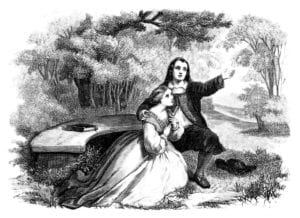Shakespeare’s plays often turn on the nature of identity, especially as it’s perceived by others. “Look like the innocent flower”, says Lady Macbeth to her anxious husband, “But be the serpent under it”. Time and again in Shakespeare’s plays, the contrast between appearance and reality is central to the drama: “I am not what I am”, says Viola to Olivia in “Twelfth Night” as she seeks to bridge the gap. The lovelorn Olivia is bemused: “I would you were as I would have you be”, she replies. But things rarely work out that way in Shakespeare’s plays.
“I am not what I am” is a resonant phrase, and much of Shakespeare’s writing depends on the essential contradiction it implies. As it happens this phrase is uttered not only by the blameless Viola in “Twelfth Night” but also by the odious Iago in “Othello”, explaining that he means to destroy his general by deceiving him: “I follow him to serve my turn upon him”, he boasts, bringing the audience into his sinister confidence. We don’t necessarily want to hear what he has to say – though there’s something compelling about the way he lies to everyone except us.
This is the first law of disguise and mistaken identity in Shakespeare: it is almost invariably underwritten by dramatic irony. Back to “Twelfth Night”: after a brief opening scene, the play goes straight to the shipwreck that brings Viola to Illyria and her decision to “Conceal me what I am” and offer herself as a male servant to Duke Orsino. Her real identity is of course a secret which the play cannot conceal indefinitely, and sure enough, revelation comes (as in “Othello”) in the course of the play’s lengthy closing scene.
Humorous use of the trope is not confined to the Comedies. In “Henry IV” Part Two, Prince Hal and his friend Ned Poins – “disguised”, so the stage direction tells us, “as drawers” [artisans] – watch as Falstaff derides him as a “shallow young fellow” who “would have made a pantler” – a kitchen assistant. Warming to his theme, Falstaff believes that Poins has “a weak mind” and adds that “the Prince himself is such another”. Once Prince Hal reveals his identity, Falstaff is reduced to bluster before the play as a whole takes a more serious turn.
Almost all Shakespeare’s most representative Comedies make some use of disguise, often – as in “Twelfth Night” – presenting a female character disguised as a male. Examples include Portia in “The Merchant of Venice”, who disguises herself as Balthazar the lawyer, and fools everyone she encounters, including her fiancé Bassanio; Rosalind in As You Like It, who disguises herself as Ganymede so as to teach Orlando how to love; and Julia in The Two Gentlemen of Verona, who disguises herself as Sebastian, before she travels to Milan to investigate what has happened to her beloved Proteus.
These are all quite innocent disguises, often founded on an ideal of service. But disguise in Shakespeare can at times have a less wholesome dimension. Take the case of Helena in All’s Well that Ends Well, who deceives Bertram into believing he has slept with the maiden Diana when in practice it was she who shared his bed. A similar trick is played in Measure for Measure, where Mariana is persuaded to take the place of Isabella in a twilight triste with the deeply unpleasant puritan Angelo. In Shakespeare’s England, once a man has slept with a woman he must marry her.
In other respects, however, disguise may have its benefits. “Measure for Measure” is an example of this more positive dimension, since at the heart of the play lies the decision of Vincentio, the Duke of Vienna, to announce that he is to leave the country for a while – though in practice he means to remain at home disguised as a monk to weigh up how well Vienna is governed. So his guise (or dis-guise) is settled for the rest of the play. A similar trick is played by Henry V in the play of his name when, on the eve of Agincourt, he borrows a cloak from Sir Thomas Erpingham, and goes undercover among his men to test their mood on the eve of battle. He is able to speak to his men on the level, and his conversations are revealing.
Disguise leads to mistaken identity – provided it’s successful. But identities can easily be confused for other reasons. Once again, “Twelfth Night” is a case in point, since Viola happens to have a twin brother who closely resembles her, and when – an unfortunate co-incidence, perhaps – he arrives on the scene, Sir Andrew challenges him to a fight and Olivia invites him to marry her. Confusing – until Viola appears and the crossed wires can be disentangled. “Twelfth Night” was written in around 1600, but it may be based in some ways on “The Comedy of Errors”, written around a decade earlier. Here again, twins appear in the same city at the same time unknown to one another, and the fact that they share the same name and that their personal servants are also twins and that they share the same name – all this only makes matters worse.
Such dramatic conventions may seem unrealistic, but then realism was never Shakespeare’s strongest suit. The drama is all, and in plays like “A Midsummer Night’s Dream”, there is plenty of comic mileage in the trope of mistaken identity. Here Puck is charged by Oberon, the king of the fairies, with issuing the love drug love-in-idleness to Demetrius. But he confuses the situation and gives it by mistake to Lysander. When he wakes up, the first girl he sees is Helena, whom he has previously spurned. But now it is she who is dismissive, deriding this sudden change of heart when he reveals his feelings for her: “Do not say so, Lysander”, she admonishes him, “say not so”.
Harmless and cheerful, episodes like these are delivered with a light touch, but mistaken identity can take many forms in Shakespeare’s work, and the late play “Cymbeline” contains a more macabre example. When Imogen’s lover Posthumus is expelled from Britain, the unattractive Cloten seeks to take his place, going so far as to wear his rival’s clothes. When Imogen escapes to the west to take up arms against the invading Romans, Cloten follows her. Inevitably he loses his life, but when his headless body is discovered (dressed in Posthumus’s clothing), Imogen is left to lament the apparent demise of her beloved Posthumus. They are reconciled in the final act.
A still more shocking case occurs towards the end of “Much Ado About Nothing”. Here the villainous Don John (a prototype Iago) is determined to destroy the happiness of young Hero and Claudio. So he devises a scene for Claudio which appears to reveal Hero’s infidelity on the eve of their wedding. It’s night-time, and the details are obscure, but Claudio is persuaded, with horrendous consequences. In practice, however, what he was watching was Don John’s associate Borachio romancing Hero’s maid, identities that are not cleared up until it’s almost too late. At the play’s end Don John is left, like Iago, to ponder on his imminent punishment.
By contrast, the early history play “Henry VI” Part One offers an example of the opposite effect: an identity very firmly established. When Joan of Arc is brought as a young woman to the French court for the first time, she is said to possess the kind of supernatural power that will help the French liberate themselves from the curse of war with the invading English. Bring her in, says the Dauphin – but first, to test these fabled supernatural powers, he invites Duke Reignier to pretend to be him. Joan is immediately on the offensive: “Reignier, is’t thou that thinkest to beguile me?” she asks. “Where is the Dauphin?” Mistaken identity is for others, implies the playwright. Joan is above that, and her powers, for better or worse, are real.
It’s an isolated example of identity not mistaken but established. More often, Shakespeare’s characters are pliable and credulous, trusting uncynically in what they see or what they’re told. Of course, it can be painful to watch: one thinks of Duncan being welcomed by Lady Macbeth to her castle. But at other times it is liberating – for example, to observe Portia hoodwink the squabbling males, just as it’s entertaining when everyone thinks Sebastian is Cesario when really she’s Viola. In the circumstances, Viola’s outburst towards the end of Act 2 Scene 2 – “Disguise, I see, thou art a wickedness” – may seem too harsh a verdict on one of Shakespeare’s most familiar tropes.




